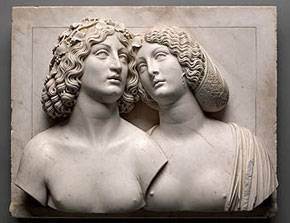
Tullio Lombardo (Italian, c. 1455 – 1532)
Bacchus and Ariadne, c. 1505
marble
overall: H. 56 cm, W 71.5 cm, D 22 cm (22 1/16 x 28 1/8 x 7 7/8 in.)
Kunsthistorisches Museum Vienna, Kunstkammer
Tullio Lombardo at the National Gallery, Washington
On view at the National Gallery of Art’s Italian galleries in the West Building from July 4 through November 1, 2009, An Antiquity of Imagination: Tullio Lombardo and Venetian High Renaissance Sculpture celebrates the artist’s pioneering talent
]]>
An Antiquity of Imagination showcases Tullio’s unprecedented masterpieces of Renaissance marble carving, never before seen in the United States. At the center of this focus exhibition are two double portraits carved in high relief from single blocks of marble: A Couple (c.1490/1495) and the so-called “Bacchus and Ariadne” (c.1505). The sensuously smooth flesh of these ideally beautiful young men and women, portrayed partially nude, contrasts with intricate detail carving in costume elements and in hair that surges with movement. Their restless expressions, with parted lips and wide-open eyes that seem to gaze into the distance, suggest states of reverie, anxiety, or yearning. They depart dramatically from conventions of late 15th-century Venetian portraiture, typically formal, reserved, and confined almost exclusively to painting. Whether Tullio’s busts were really meant as portraits remains a mystery.
Although groundbreaking, Tullio’s double-portrait busts drew on various ancient sources, including Roman funerary reliefs and cameo portraits, and expressive figures from the Hellenistic Greek world, with supple flesh and parted lips. In addition, Tullio seems to have been aware of northern European double portraits in painting and prints.
The exhibition presents other close-up bust-length images, in relief and in the round, that display Tullio’s sensuous and expressive qualities. They include his own soulful, curly haired Relief Bust of a Youth (c.1505) as well as Simone Bianco’s Bust of a Woman (c.1515/1520), in a pleated gown that falls suggestively open, and Antonio Minello’s Grieving Heroine (1520s), a delicate miniature bust with elaborately bound and loosened hair winding over her bare shoulders.
Also featured are sculptures from Venetian churches that develop the spiritual character of the mysterious emotions suggested by Tullio’s work: Saint Sebastian (1520s), a bust-length relief with teeth bared in anguish, by a follower of Tullio and Antonio; Relief Bust of a Young Male Saint (c.1510–1516), by Tullio, carved nearly in the round; and Standing Angel (c.1495/1500), by a Venetian artist, possibly Giambattista Bregno.
Reliefs of antique subjects became a specialty of Antonio Lombardo (c.1458–c.1516), a court sculptor to Duke Alfonso I d’Este of Ferrara, the patron who commissioned the celebrated Feast of the Gods, by Bellini and Titian, now in the National Gallery of Art. On view are examples of similar small reliefs, depicting full-length figures in action, perhaps designed for installation in private studies: Peace Establishing Her Reign (c.1512/1520), a bronze allegory from a model attributed to Antonio or to his follower Giammaria Mosca (c.1493/1495–c.1574), which was possibly designed as a pendant to the marble high relief of the god of war Mars (c.1515/1520), from the circle of Antonio. A marble with colored stone inlay depicts the tragic Roman heroine Lucretia (1520s), shown as an ideal nude figure, from the circle of Antonio and Giammaria Mosca.
The Tullio Lombardo exhibition occupies galleries adjoining the National Gallery of Art’s extensive collection of Venetian Renaissance paintings, many of which invite comparison with Tullio’s works. Two related paintings will be part of the exhibition. In Judith with the Head of Holofernes (c.1495/1500) by Andrea Mantegna (c.1431–1506) or follower, possibly Giulio Campagnola (1482–after 1514), Judith’s tilted head and faraway gaze seems to share the expressive aims of Tullio and Antonio. Conversely, small marble reliefs from the Lombardo circle, such as Lucretia, reflect an appreciation of Mantegna’s small paintings of ancient heroes.
In Saint Helena (c. 1495) by the Venetian altarpiece painter Cima da Conegliano (c.1459–1517 or 1518), the mother of the Roman emperor Constantine appears in a classicizing breastplate, with a pensive gaze, a shifted-weight stance, and a cloak and skirt falling in rigid folds that indicate Cima’s admiration for both ancient sculpture and Tullio’s statuettes.
Follow us on:

